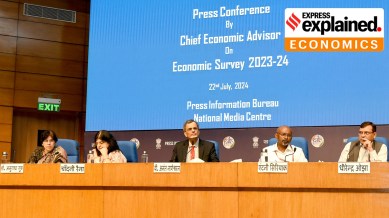Udit Misra is Senior Associate Editor. Follow him on Twitter @ieuditmisra ... Read More
© The Indian Express Pvt Ltd

The Economic Survey for 2023-24 stands out from previous economic surveys in that it provides a more realistic picture of the challenges before India’s economic growth. As such, despite India’s GDP growing at more than 8% in FY 2023-24, the survey pegs the GDP growth rate for the current financial year (FY 2024-25) between 6.5% and 7%.
Here are some key challenges that the survey flags, and the recommendations it makes to address these.
Global headwinds: The environment for foreign direct investment (FDI) to grow in the coming years is not highly favourable. High interest rates in developed countries have not only raised the cost of funding, but also increased the opportunity cost to invest in developing countries like India. Moreover, economies such as India have to compete with industrial policies in the developed world involving considerable subsidies that encourage domestic investment. Geopolitical uncertainties also continue to play spoilsport.
Follow Budget 2024 Live Updates
China challenge: The Chief Economic Advisor (CEA) underscored how India continues to be overly dependent on China for imports, especially for renewable energy. He also stated that China has not let go of the low-skills manufacturing space that India wanted to occupy.
AI threat: The Survey notes that while there has been a boom in telecommunications and Internet facilitated business process outsourcing (BPO), the next wave of technological evolution might bring the curtains down on it.
Tepid private investment: The Survey emphasised that the corporate sector had not responded, despite the Union government cutting taxes in September 2019 to facilitate capital formation. “…Between FY20 and FY23, the profit before taxes of the Indian corporate sector nearly quadrupled…Hiring and compensation growth hardly kept up with it,” the CEA stated in the Survey.
Data deficiency: A constant refrain against the government has been the lack of good quality and timely data especially related to employment. In the Survey, the CEA accepted that this was indeed a gap that was holding back a proper analysis. “The lack of availability of timely data on the absolute number of (formal and informal) jobs created even at annual intervals, let alone at higher frequencies, in various sectors — agriculture, industry including manufacturing and services — precludes an objective analysis of the labour market situation in the country,” it stated.
Lifestyle disadvantages: The Survey notes that “social media, screen time, sedentary habits, and unhealthy food are a lethal mix that can undermine public health and productivity and diminish India’s economic potential.”
Job creation by the private sector: One of the central pillars of the past two Narendra Modi governments has been the determination to reduce the role of government in the economy and incentivise the private sector to take over the dominant position. In doing so, the government had hoped that the private sector would create jobs. The Survey reiterated that hope: “…It is in the enlightened self- interest of the Indian corporate sector, swimming in excess profits, to take its responsibility to create jobs seriously.”
Lifestyle changes by private sector: “India’s traditional lifestyle, food and recipes have shown how to live healthily and in harmony with nature and the environment for centuries. It makes commercial sense for Indian businesses to learn about and embrace them, for they have a global market waiting to be led rather than tapped,” writes the CEA.
Farm sector as the saviour: Traditional economic theories suggest that as economies develop they make a structural transition from agriculture to manufacturing and services. But the Survey states that “trade protectionism, resource-hoarding, excess capacity and dumping, onshoring production and the advent of AI are narrowing the scope for countries to squeeze out growth from manufacturing and services” and “forcing us” to turn conventional wisdom on its head. In other words, the CEA states, “A return to roots, as it were, in terms of farming practices and policy making, can generate higher value addition from agriculture, boost farmers’ income, create opportunities for food processing and exports and make the farm sector both fashionable and productive for India’s urban youth”.
Removing regulatory bottlenecks: “The Licensing, Inspection and Compliance requirements that all levels of the government continue to impose on businesses is an onerous burden. Relative to history, the burden has lightened. Relative to where it ought to be, it is still a lot heavier,” stated the CEA. He singled out the Medium, Small and Micro Enterprises (MSMEs) as one sector that required to be relieved of regulatory burden the most.
Building state capacity: The CEA noted that what was needed in the economy now was not big reforms but the grunt work. To this end it advocated building up state capacity for sustaining and accelerating India’s progress.